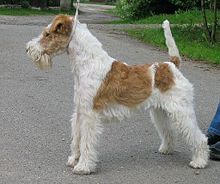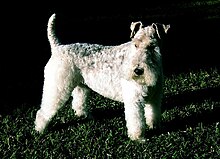Wire Fox Terrier
This article needs additional citations for verification. (May 2007) |
| Wire Fox Terrier | |||||||||
|---|---|---|---|---|---|---|---|---|---|
 A Wire Fox Terrier (Ginger) | |||||||||
| Other names | Wire Hair Fox Terrier Wirehaired Terrier Fox Terrier | ||||||||
| Common nicknames | Foxie | ||||||||
| Origin | England | ||||||||
| |||||||||
| Dog (domestic dog) | |||||||||
The Wire Fox Terrier is a breed of dog, one of many terrier breeds. It is an instantly recognizable fox terrier breed. Although it bears a resemblance to the Smooth Fox Terrier, they are believed to have been developed separately.
Appearance

The wire fox terrier is a sturdy, balanced dog weighing between 7 and 9.5 kg (15 and 21 lb). Its rough, broken coat is distinctive. Coat color consists of a predominant white base with brown markings of the face and ears, and usually a black saddle or large splotch of color; there may be other black or brown markings on the body. The wire in the photo at left sports the traditional white, black and buff tri-color coat. The wire in the upper right hand photo appears to be a ginger, a wire without black markings.
Temperament
Two of the Wire Fox Terriers' most distinctive traits are their enormous amount of energy and intelligence. They have a low threshold for boredom and require stimulation, exercise and attention. Indeed, once absorbed into the family, they are an inquisitive pet with a nose for everybody's business. They particularly enjoy comfort time on the couch or in bed in the evening, the wirefox is a true companion animal. Most of them truly love water and are always up for a swim. A life jacket is recommended for them. The Wire Fox Terrier should be alert, quick and ready to respond swiftly with enthusiasm. However they should also be friendly, communicative and exceedingly playful if they receive the proper care and exercise. Bred to be independent thinkers, they are capable of tactical maneuvering for vermin and other sport. Because of their high level of intelligence and energy, they are a dog that is not suited for everyone.
Grooming
Wire Hair Fox Terriers are hand stripped; if the hair becomes too long, their hair should be taken out by hand in order to preserve the colors and the glossiness of the coat. Many Wire Fox pets are clipped 3 - 4 times a year by a groomer. Clipping dulls the colors and makes the coat soft, curly and more difficult to keep clean, but is considered acceptable and comfortable by many owners.

History
The wire fox terrier was developed in England by fox hunting enthusiasts and is believed to be descended from a now-extinct rough-coated, black-and-tan working terrier of Wales, Derbyshire, and Durham. The breed was also thought to have been bred to chase foxes into their underground burrows; the dogs' short, strong, usually docked tails were used as handles by the hunter to pull them back out.

Although it is said Queen Victoria owned one, and her son and heir, King Edward VII of Great Britain did own the wire fox terrier, Caesar, the wire fox terrier was not popular as a family pet until the 1930s, when The Thin Man series of feature films was created. Asta, the canine member of the Charles family, was a Wire-Haired Fox Terrier, and the popularity of the breed soared. Milou (Snowy) from The Adventures of Tintin comic strip is also a Wire Fox Terrier.
In the late 20th century, the popularity of the breed declined again, most likely due to changing living conditions in the Western world and the difficulty of keeping hunting terriers in cities due to their strong prey instincts.
As of 2010, the wire fox terrier has the distinction of having received more Best in Show titles at Westminster Kennel Club dog shows (currently 13) than any other breed.[1] Wire fox terriers kept as pets show the loyalty, intelligence, independence, playfulness and breeding befitting such a storied breed.
Ch. Matford Vic, a Wire Fox Terrier, is one of only five dogs to have won the Westminster Kennel Club Dog Show on more than one occasion. He won the competition twice, in 1915 and 1916. The only dog to win it on more occasions was Ch. Warren Remedy, a Smooth Fox Terrier, who won it on three occasions between 1907 and 1909.[2]
Noteworthy Wire Fox Terriers
- Archie, owned by Gill Raddings Stunt Dogs starred in ITV's Catwalk Dogs.
- Asta, from The Thin Man films adaptation (the novel's breed was a Schnauzer)
- Bob, from the Hercule Poirot episode Dumb Witness
- Bunny, from Hudson Hawk
- Caesar, the companion of King Edward VII of the United Kingdom
- Charles, brought to Ceylon by Leonard Woolf in 1905
- Chester, in the film Jack Frost
- Dášeňka, the dog of Czechoslovak writer and journalist Karel Čapek - also featured as main hero of "Dášeňka čili život štěněte" book.
- George, from Bringing Up Baby
- Ike Larue, from the Ike Larue series, written and illustrated by Mark Teague
- Moll, from the book "Memoirs of a Fox Hunting Man"
- Montmorency, from the book Three Men in a Boat by Jerome K. Jerome
- Mr. Atlas, from Topper Takes a Trip (played by Skippy)
- Mr. Smith, from The Awful Truth
- Nellie, inspiration for Nellie the Lighthouse Dog (Nellie was formerly known as Hockney) by Jane Scarpino; Nellie's owner, Robert Ensor, illustrated
- Pan, the companion of A.L. Westgard, AAA pathfinder. Pan was the mascot of the dedication tour for the National Park to Park Highway in 1920.
- Polly, a white rough terrier companion to Charles Darwin
- Rufus from Open Season 2.
- Scruffy, the Muirs' Wire Fox Terrier on The Ghost and Mrs. Muir
- Skippy, starred as Asta in The Thin Man, and other movies
- Snowy (French: Milou), companion of Tintin
- "The dog," from the Selchow and Righter board game "Mr. Doodle's Dog"
- Wessex, the wire of British novelist ("Tess of the d'Ubervilles") Thomas Hardy
- Willy, from Ask the Dust
- Wuffles, the Patrician's dog in the Discworld Series
Asta, George, Mr. Smith and Skippy were all played by the canine actor, Skippy.
See also
- Fox Terrier, for additional details on history, genetics, coat color, and so on.
External links
References
- ^ "Best in Show Winners". The Westminster Kennel Club. Retrieved 2011-01-20.
- ^ "Best in Show Winners". The Westminster Kennel Club. Retrieved 2009-12-28.
